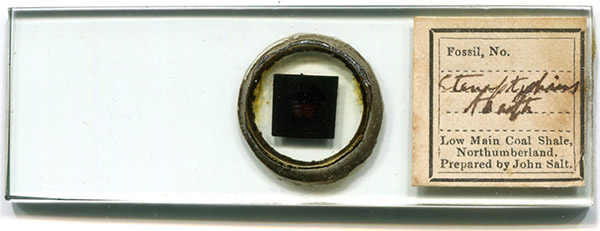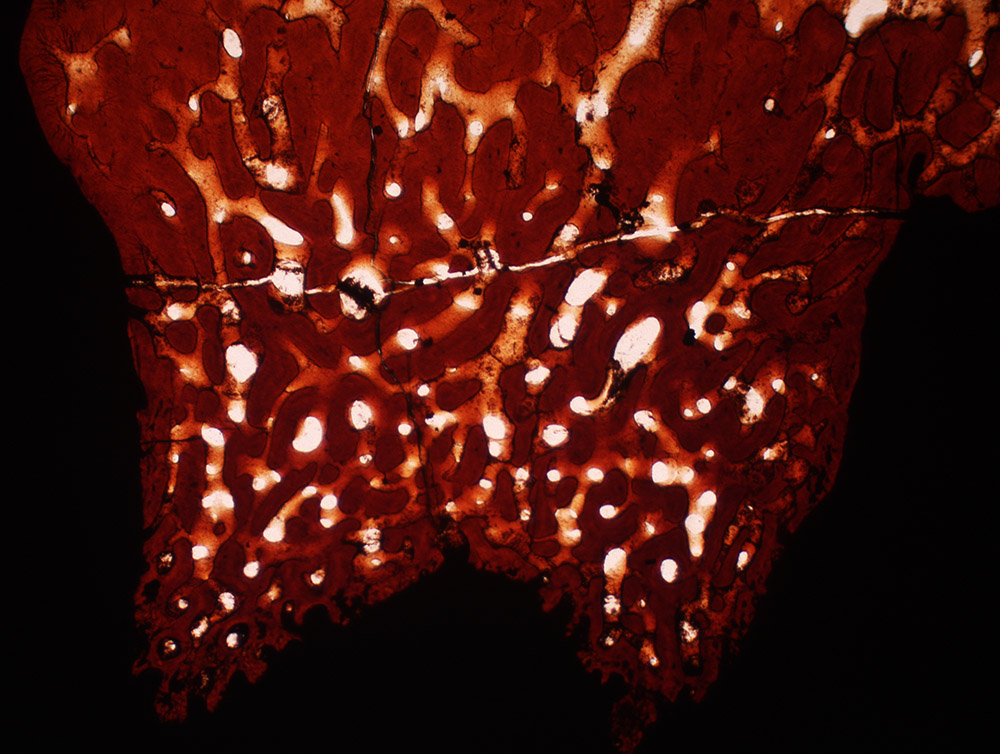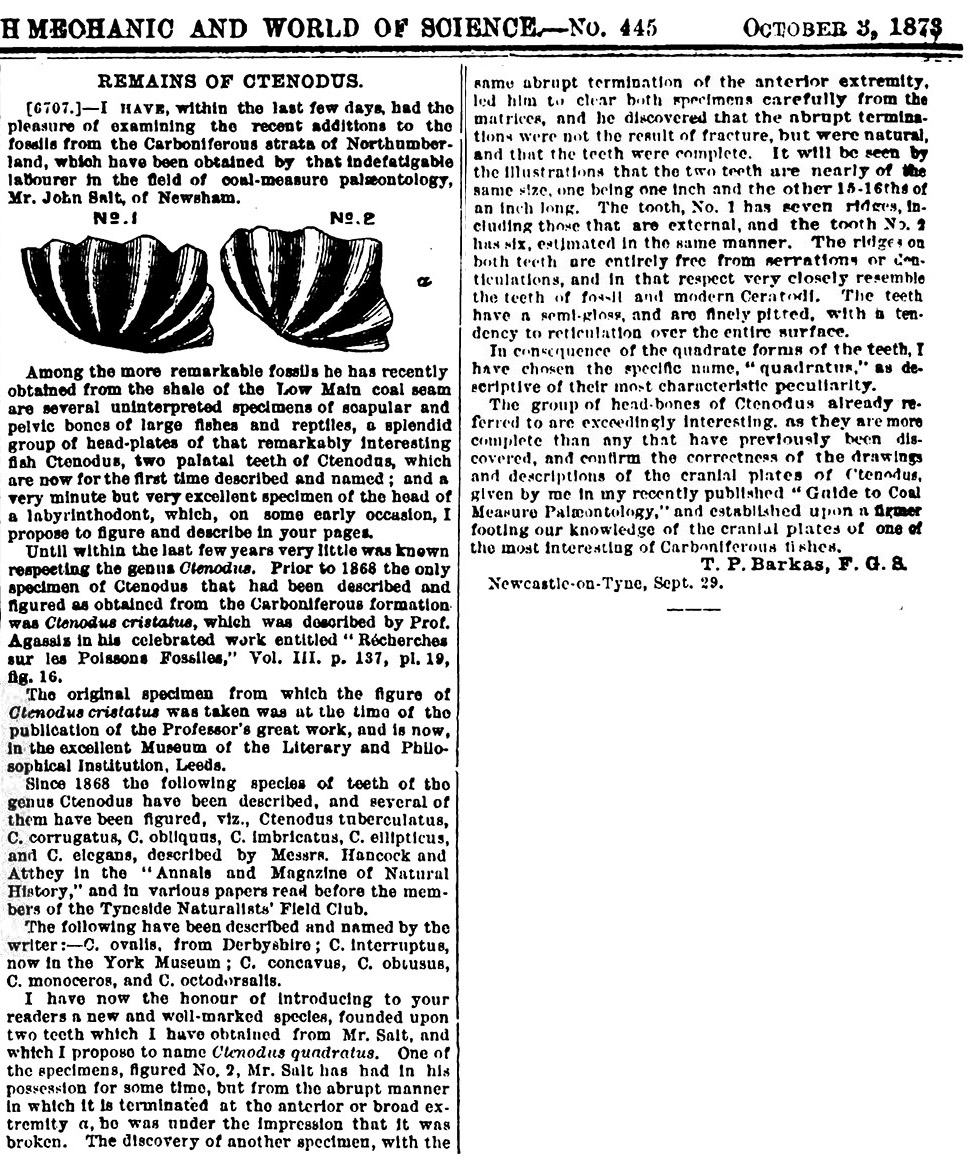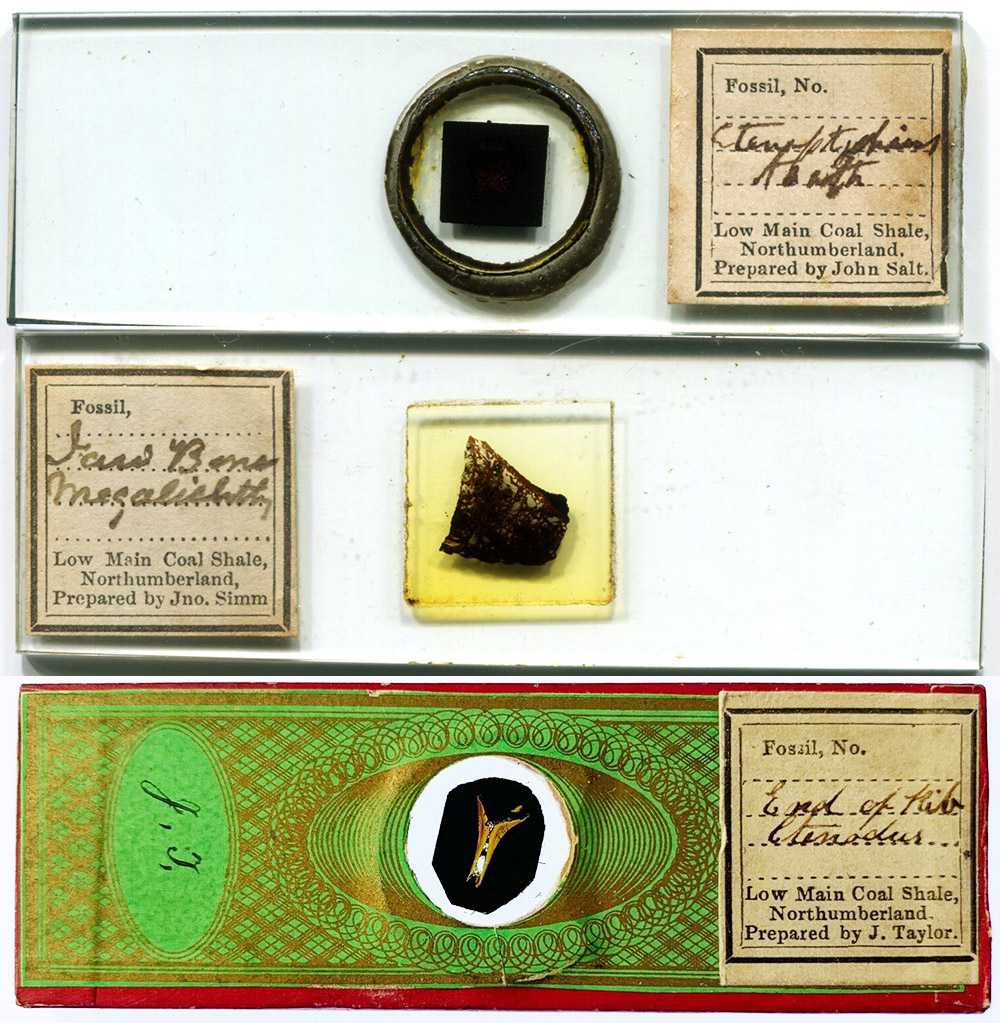
Figure 1. Circa 1873 microscope slide of a section of coal that bears a tooth from a Ctenodus spp. lungfish, prepared by John Salt.
John Salt, ca. 1840 – after 1875
by Brian Stevenson
last updated April, 2021
Although John Salt was a coal miner who spent long days laboring underground, he was an avid microscopist who reportedly possessed a "very excellent microscope". He became known for preparing slides of fossil fish and other creatures that he found in coal deposits. He provided many early fossils of Ctenodus (a genus of lungfish) that helped characterize the genus. Salt is known to have been an active microscopist during the first half of the 1870s, but seems to have disappeared from records after 1875.

Figure 1.
Circa 1873 microscope slide of a section of coal that bears a tooth from a Ctenodus spp. lungfish, prepared by John Salt.

Figure 2.
Section through a tooth of a Ctenodus. Photographed with transmitted light, a 3.5x objective lens, and a C-mounted digital SLR camera.

Figure 3.
1873 description of Ctenodus teeth that were discovered by John Salt, written by Thomas P. Barkas and published in "The English Mechanic and World of Science".
Very little is known about John Salt's life.
He was mentioned as a source of fossils from coal beds by Thomas P. Barkas in his 1873 Illustrated Guide to the Fish, Amphibian, Reptilian, and Supposed Mammalian Remains of the Northumberland Carboniferous Strata, "I have, during the progress of my investigations into Coal Measure Fauna, which have now extended over five years, been much indebted to Messrs. Simm and Taylor, of West Cramlington, and Mr. J. Salt, of Newsham, all of whom have kindly placed their large and valuable collections of fossils at my disposal". In that same work, Barkas further acknowledged, "I have recently had the pleasure of examining a splendid specimen of the teeth and head bones of Ctenodus tuberculatus, the property of Mr. John Salt, of Newsham".
Barkas also wrote of John Salt's discovery of fossil teeth from another species of Ctenodus in The English Mechanic and World of Science, 1873 (Figure 3).
Additionally, Salt was one of four Northumberland coal miners who were described by Edward Young in his 1875 report, Labor in Europe and America, in a section on English "Miners with scientific tastes": "John Salt, Newsham colliery, about thirty-three years of age, has made a large collection of coal-measure fishes and labyrinthodont, and has found the largest and best specimens of labyrinthodont that have been found in any part of the world. His collection, gathered by his own hands, was unique. He also made microscopical sections, and he, and the other miners, Simms and Taylor, first possessed very excellent microscopes. They all had good libraries. Mr. Salt has removed to Staffordshire".
Searches of census and other records found that, in 1871, a John Salt, "coal miner", aged 31, lived in North Newsham (Figure 4), an age and dwelling place that are consistent with Young's description. No other John Salt has been identified in census records of the vicinity. Thus, our microscopist was born ca. 1840 in Birmingham, Warwickshire. His wife, Mary, was from Durham, and the pair had a son, Thomas, born in 1870 in Wardley, Durham.
Young stated that Salt had "removed to Staffordshire" by 1875. Searches of census and other records have failed to locate him there or elsewhere in the U.K. There was another John Salt in Staffordshire, who managed the Chatterley coal and iron mine through the 1880s and 1890s, but census records indicate that he was already living in Staffordshire in 1871, was born ca. 1845 in Endon, Staffordshire, had a wife named Annie, and had a son named Charles who was born ca. 1867. Thus, the fate of our microscopist remains unknown.
Edward Young's 1875 report and Barkas' 1873 book included two other coal-mining microscopists of note: John Simm and Joseph Taylor. The lives and works of both of those men are described in other assays on this site. It is especially notable that Salt, Simm, and Taylor all produced microscope slides of coal sections that have essentially identical printed labels (Figure 5). This suggests that the three men may have studied microscopy together. Alternatively, as all three were acknowledged by Barkas in his book on coal fossils (see above), it is possible that he or someone else marketed slides that were made by those miners.
To round out this story, Young's 1875 description of Simm and Taylor:
"John Simm, West Cranleyton, son of an ingenious miner who died several years ago; his son John works in West Cranleyton colliery, and has worked there from boyhood; he is about forty years of age; works as a heaver of coal. He has made great progress in the study of the fossil and reptile remains of the north coal-districts, and as a very large and good collection. He also works with the microscope and prepares microscopical objects; his preparations of fish-remains are very good. He is interested in butterflies and moths, and his knowledge of local natural history is very creditable".
"Joseph Taylor, a workingman, residing at West Cranleyton, is a relative of Mr. Simms by marriage, and his tastes and capacities very similar to those possessed by his brother-in-law. He has a good collection of lower coal-measure fossils; he also mounts objects for the microscope, and he and Mr. Simms both supplied Mr. West the slides for his work on coal-measure paleontology. Mr. Taylor is about forty years of age, and for several years has devoted his leisure hours to paleontology".
Young also described a fourth Northumberland/Durham miner/microscopist:
"David Knight, who was killed by an accident in Dudley colliery, Northumberland, about five years ago, was a very ingenious working miner; he collected fossils, butterflies, &c. and constructed a microscope; ground his own lenses, and fitted up the instrument himself. He also invented a machine for grinding lenses for telescopes and microscopes. He contributed several articles on mathematics to local journals, and was an ingenious and industrious man".
Knight's tragic, early death is a reminder that coal mining was, and still is, a dangerous occupation. That may be why John Salt disappeared from records after the mid-1870s.

Figure 4.
Excerpt from the 1871 census of England.

Figure 5.
Microscope slides of fossils in coal sections that were made by John Salt, John Simm, and Joseph Taylor, having essentially identical printed labels. It is not known whether they cooperated in purchasing printed labels, or if their works were marketed through a unified source. From the author's collection or adapted for nonprofit, educational purposes from an internet auction site.
Resources
Barkas, Thomas P. (1873) Illustrated Guide to the Fish, Amphibian, Reptilian, and Supposed Mammalian Remains of the Northumberland Carboniferous Strata, W.M. Hutchings, London, pages iv and 114
Barkas, Thomas P. (1873) Remains of Ctenodus, The English Mechanic and World of Science, Volume 18, page 68
England census and other records, accessed through ancestry.com
Young, Edward (1876) Labor in Europe and America: A Special Report on the Rates of Wages, the Cost of Subsistence, and the Condition of the Working Classes, in Great Britain, France, Belgium, Germany, and Other Countries of Europe, also in the United States and British America, S.A. George & Co., Philadelphia, page 417